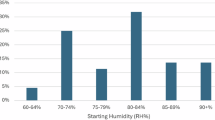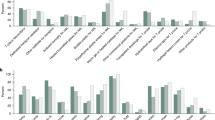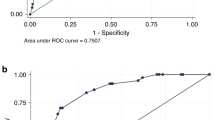Abstract
Objective
To determine the insensible water losses (IWL) in preterm infants cared for in incubators with 70% or 90% relative humidity (RH).
Study design
This was a single center retrospective study of extremely preterm infants between 22- and 28-weeks gestational ages nursed in 70% and 90% RH. IWL was calculated using a formula that utilized infants’ fluid intake, urine output and body weight changes. IWL between the two groups were compared using independent t-test. Multivariate linear regression was used to assess the effects of humidity on IWL after adjusting for confounding variables.
Results
IWL was higher in infants nursed in 70% RH when compared with those nursed in 90% RH (47.7 ± 30.3 vs. 28.8 ± 39.6, p = 002). Multivariate linear regression analysis showed that RH has an independent effect on the insensible water loss.
Conclusion
Extremely preterm infants nursed in incubator with 70% RH have higher IWL than infants nursed in 90% RH.
This is a preview of subscription content, access via your institution
Access options
Subscribe to this journal
Receive 12 print issues and online access
$259.00 per year
only $21.58 per issue
Buy this article
- Purchase on SpringerLink
- Instant access to full article PDF
Prices may be subject to local taxes which are calculated during checkout
Similar content being viewed by others
Data availability
Due to restrictions from the local Institutional review, access is restricted to qualified researchers and requires approval from the Institutional Review Board. Contact the corresponding author for details.
References
Kjartansson S, Arsan S, Hammarlund K, Sjörs G, Sedin G. Water loss from the skin of term and preterm infants nursed under a radiant heater. Pediatr Res. 1995;37:233–8.
Maayan-Metzger A, Yosipovitch G, Hadad E, Sirota L. Transepidermal water loss and skin hydration in preterm infants during phototherapy. Am J Perinatol. 2001;18:393–6.
Karlsson V, Heinemann AB, Sjors G, Nykvist KH, Ågren J. Early skin-to-skin care in extremely preterm infants: thermal balance and care environment. J Pediatr. 2012;161:422–6.
Ågren J, Sjörs G, Sedin G. Transepidermal water loss in infants born at 24 and 25 weeks of gestation. Acta Paediatr. 1998;87:1185–90.
Doyle LW, Sinclair JC. Insensible water loss in newborn infants. Clin Perinatol. 1982;9:453–82.
Kurimoto T, Ibara S, Ishihara C, Naito Y, Hirakawa E, Yamamoto T. Incubator humidity and temperature control in infants born at 22-23 weeks’ gestation. Early Hum Dev. 2022;166:105550.
Ågren J, Segar JL, Söderström F, Bell EF. Fluid management considerations in extremely preterm infants born at 22-24 weeks of gestation. Semin Perinatol. 2022;46:151541.
Sung SI, Ahn SY, Seo HJ, Yoo HS, Han YM, Lee MS, et al. Insensible water loss during the first week of life of extremely low birth weight infants less than 25 gestational weeks under high humidification. Neonatal Med. 2013;20:51–7.
Mirza H, Garcia J, Bell C, Jones K, Flynn V, Pepe J, et al. Fluid Intake in the First Week of Life and Duration of Hemodynamically Significant Patent Ductus Arteriosus in Extremely Preterm Infants. Am J Perinatol. 2021;40:1345–50.
Valentine GC, Perez KM, Wood TR, Mayock DE, Comstock BA, Puia-Dumitrescu M, et al. Postnatal maximal weight loss, fluid administration, and outcomes in extremely preterm newborns. J Perinatol. 2022;42:1008–16.
Oh W, Poindexter BB, Perritt R, Lemons JA, Bauer CR, Ehrenkranz RA, et al. Association between fluid intake and weight loss during the first ten days of life and risk of bronchopulmonary dysplasia in extremely low birth weight infants. J pediatr 2005;147:786–90.
Guo MMH, Chung CH, Chen FS, Chen CC, Huang HC, Chung MY. Severe bronchopulmonary dysplasia is associated with higher fluid intake in very low-birth-weight infants: a retrospective study. Am J Perinatol. 2015;32:155–62.
Matsushita FY, Krebs VLJ, Ferraro AA, de Carvalho WB. Early fluid overload associated with mortality and prolonged mechanical ventilation in extremely low birth weight infants. Eur J Pediatr. 2020;179:1665–71.
Bell EF, Acarregui MJ. Restricted versus liberal water intake for preventing morbidity and mortality in preterm infants. Cochrane Database Syst Rev. 2014;2014:CD000503.
Tammela OK, Koivisto ME. Fluid restriction for preventing bronchopulmonary dysplasia? Reduced fluid intake during the first weeks of life improves the outcome of low‐birth‐weight infants. Acta Paediatr. 1992;81:207–12.
Gaylord MS, Wright K, Lorch K, Lorch V, Walker E. Improved fluid management utilizing humidified incubators in extremely low birth weight infants. J Perinatol. 2001;21:438–43.
de Goffau MC, Bergman KA, de Vries HJ, Meessen NE, Degener JE, van Dijl JM, et al. Cold spots in neonatal incubators are hot spots for microbial contamination. Appl Environ microbiol. 2011;77:8568–72.
Tukey JW. Exploratory Data Analysis. Addison-Wesley. ISBN 978-0-201-07616-5. 1977.
Bobbitt Z. How to Identify Outliers in SPSS. Available at https://www.statology.org/outliers-spss. Published June 2020.
Hammarlund K, Sedin G, Strömberg B. Trans epidermal water loss in newborn infants: VIII. Relation to gestational age and post‐natal age in appropriate and small for gestational age infants. Acta Paediatr. 1983;72:721–8.
Agren J, Sjörs G, Sedin G. Ambient humidity influences the rate of skin barrier maturation in extremely preterm infants. J Pediatr. 2006;148:613–7.
Mathanda TR, M Bhat R, Hegde P, Anand S. Transepidermal water loss in neonates: baseline values using a closed-chamber system. Pediatr Dermatol. 2016;33:33–7.
Sedin G, Hammarlund K, Nilsson GE, Strömberg B, Oberg PA. Measurements of transepidermal water loss in newborn infants. Clin Perinatol. 1985;12:79–99.
Darnall RA Jr. Insensible weight loss measurements in newborn infants: possible overestimation with the Potter baby scale. J Pediatr. 1981;99:794–7.
Acknowledgements
We thank the nursing staff of the NICU for their efforts in documenting the fluids and weight data of the study population.
Funding
This study was supported by an unrestricted grant from Draeger Inc. Germany. Draeger Inc. did not influence the design, conduct, analysis or manuscript preparation of this study.
Author information
Authors and Affiliations
Contributions
ND: Conceptualized the study, designed the study and prepared the manuscript. DR: Participated in study design and collected data for the study. JZ: Performed data analysis and prepared data tables. JP: Helped with study design and statistical analysis plan. WO: Conceived the idea, helped with study design and prepared the manuscript.
Corresponding author
Ethics declarations
Competing interests
The authors declare no competing interests.
Ethics approval and consent to participate
The study was approved by the Institutional Review Board at AdventHealth, Orlando (Registration number: IORG0000516). All experimental procedures were conducted in accordance with the relevant institutional, national, and ethical guidelines and regulations. Since this was a retrospective cohort study, waiver was given for informed consent by the Institutional Review Board. Our study does not have any images from human research participants.
Additional information
Publisher’s note Springer Nature remains neutral with regard to jurisdictional claims in published maps and institutional affiliations.
Rights and permissions
Springer Nature or its licensor (e.g. a society or other partner) holds exclusive rights to this article under a publishing agreement with the author(s) or other rightsholder(s); author self-archiving of the accepted manuscript version of this article is solely governed by the terms of such publishing agreement and applicable law.
About this article
Cite this article
Dereddy, N., Ruth, D., Zhu, J. et al. Insensible water loss in extremely preterm infants cared for in incubators with 70% and 90% relative humidity. J Perinatol (2025). https://doi.org/10.1038/s41372-025-02261-w
Received:
Revised:
Accepted:
Published:
DOI: https://doi.org/10.1038/s41372-025-02261-w



